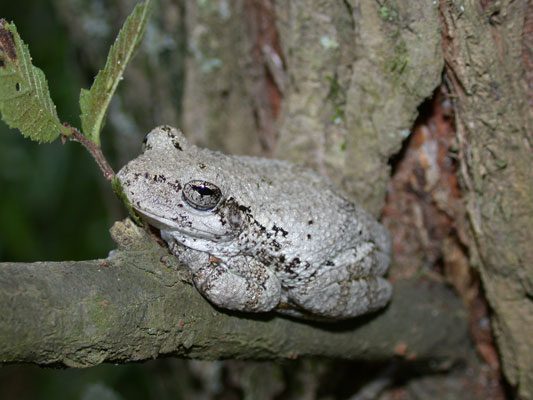A new game of ‘frogger’

Last week while surveying one of our properties, a natural heritage field biologist found an interesting species never before documented this far south – the eastern gray tree frog (Hyla versicolor). The gray tree frog found widely across the state is the Cope’s gray tree frog (Hyla chrysoscelis). The eastern gray tree frog was documented only in a small portion of two N.C. counties near the Virginia border. This finding extends the range of this species much farther south than was previously known.
The biologist identified them through a subtle difference in the calls. The versicolor has a much lower pitch and slower call that is more song-like. With birds, when we hear something interesting, we confirm it with a sighting through binoculars. These two gray tree frogs, however, are virtually indistinguishable from one another by sight. They have one interesting distinction, though: The eastern gray tree frog is a tetraploid. That means it has an extra set of chromosomes (48 rather than 24). It also means they cannot mate and have offspring with other tree frogs, one reason they are truly a distinct species. Finally, it means the only way to truly confirm the species is to catch one and do genetic work.
So, one recent day, I met the biologist to try to track down one of these little critters. As tree frogs, they are arboreal most of the time, meaning they stay in the tops of trees, which helps them avoid getting eaten and gives them a prime spot for feeding on insects. But they do come down for one thing – to mate. Around dusk, they climb down and find their way to the edge of water, and the males will croak to attract a female, who will then lay her eggs in the water’s edge.
 So just before dark we headed to the field where he had heard them, to try to trap one. We had barely made it on the property when we heard them them – and we heard both species, which makes it easy to tell the difference. It also makes ours the only site in North Carolina where both species are known to occur. Through waist-high stinging nettle and the silty mud of the South Yadkin River, we found our way down to a floodplain pool and waited. Rain and a thunderstorm earlier meant it could be a good night for frogs to be out looking for a mate. But though we heard them off and on, they decided it was not a good night to come down. It’s a little late in the season, too, so we’ll have to try again earlier next spring.
So just before dark we headed to the field where he had heard them, to try to trap one. We had barely made it on the property when we heard them them – and we heard both species, which makes it easy to tell the difference. It also makes ours the only site in North Carolina where both species are known to occur. Through waist-high stinging nettle and the silty mud of the South Yadkin River, we found our way down to a floodplain pool and waited. Rain and a thunderstorm earlier meant it could be a good night for frogs to be out looking for a mate. But though we heard them off and on, they decided it was not a good night to come down. It’s a little late in the season, too, so we’ll have to try again earlier next spring.
These tree frogs are excellent climbers and can be quite acrobatic, swinging from limb to limb as they ascend to their arboreal perches. Their toes have a suction-like shape and quality and a mucous that helps them adhere to almost any surface. You may have seen tree frogs clinging to the windows of your house. Gray tree frogs can even camouflage themselves to their surroundings, quickly changing between gray and green.
Although we didn’t catch an eastern gray tree frog, at least we had clearly heard the distinct differences in the calls of both frogs. Although you might find Cope’s gray tree frogs in your back yard, the eastern gray tree frogs prefer more wooded habitats. The mature hardwood floodplain pool where we waited is on a land-trust-protected preserve, so these eastern tree frogs have a permanent home.
Listen to the difference in the calls between the Cope’s gray and the common gray tree frogs on the Davidson herpetology website.
Top Photograph by J.D. Wilson of Virginia Tech. Yadkin river photo by Crystal Cockman.